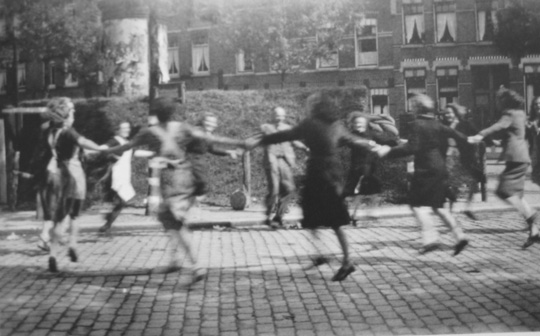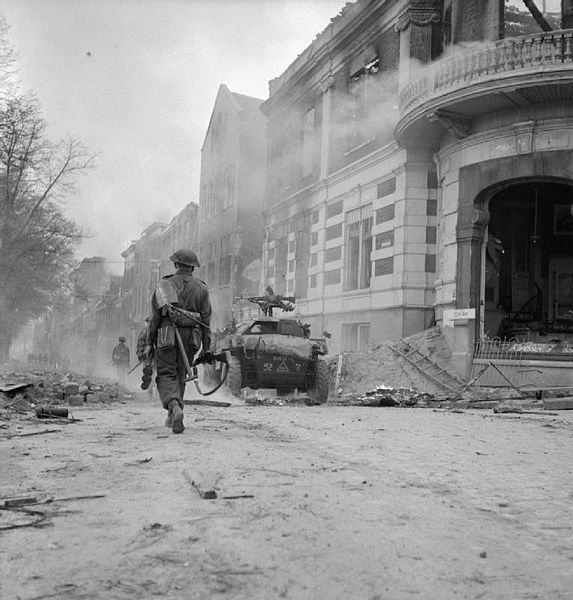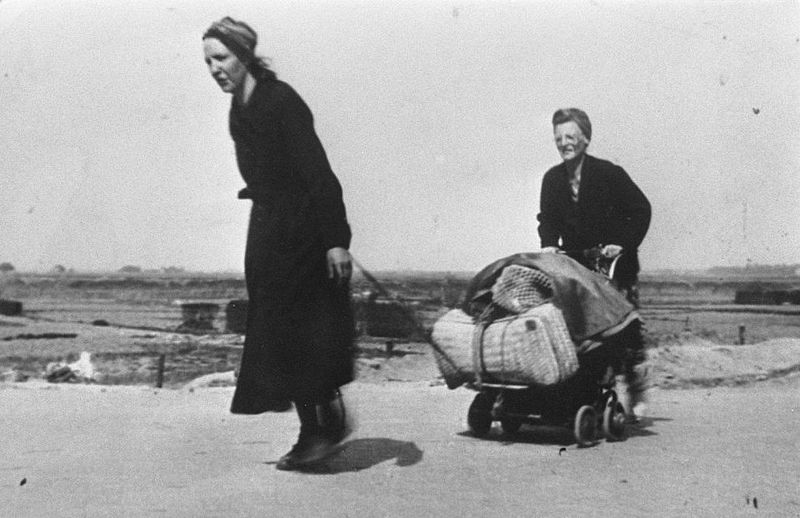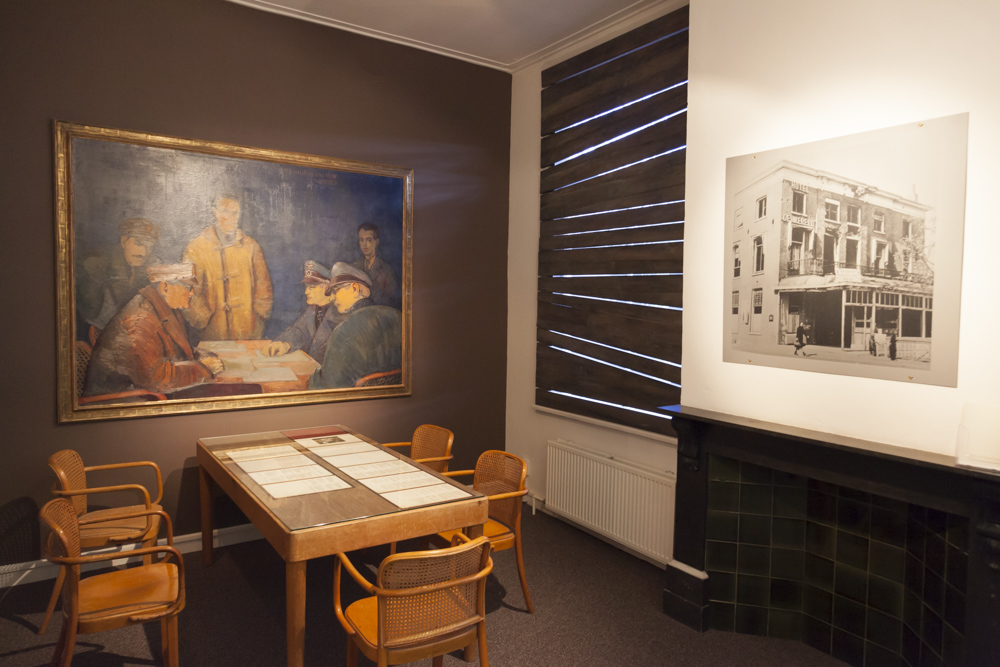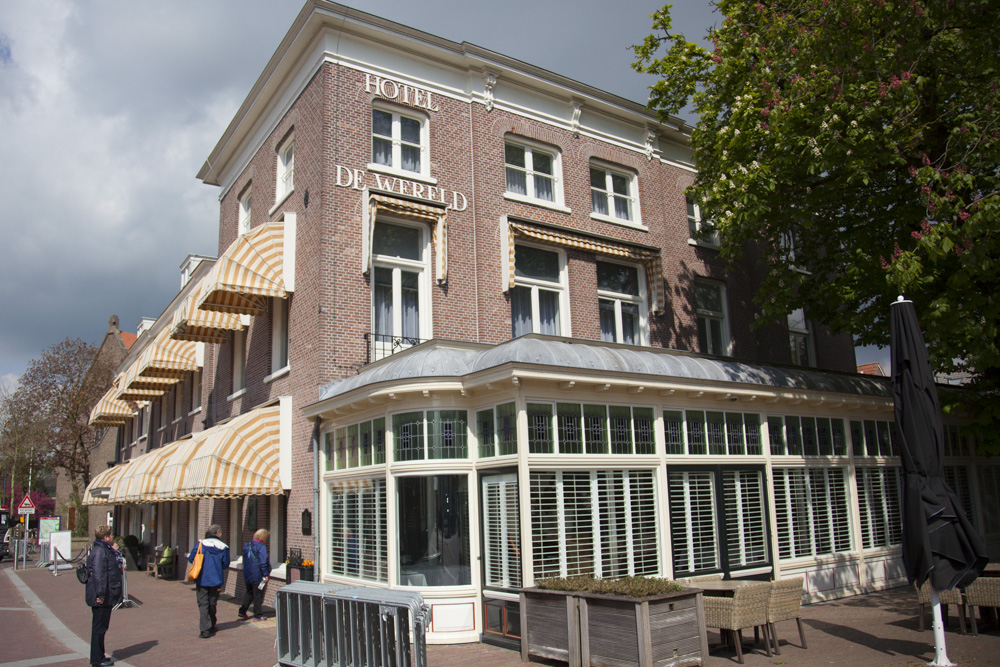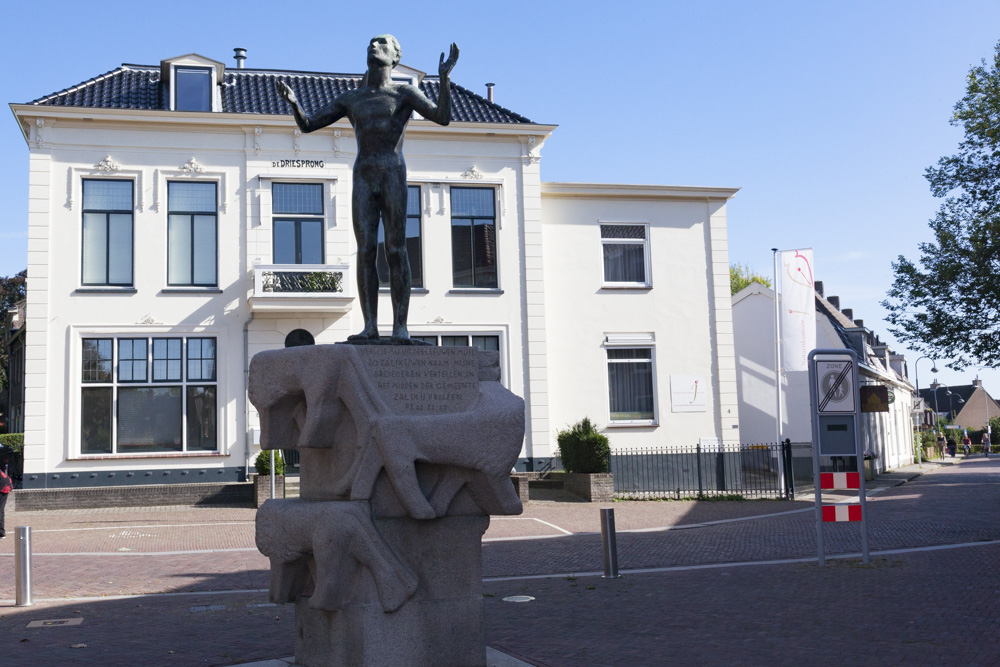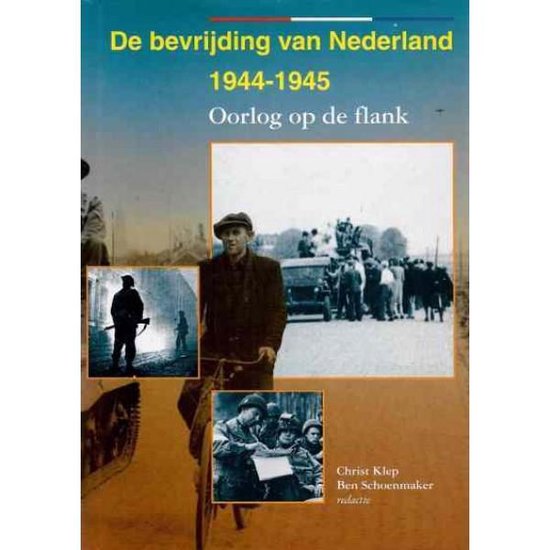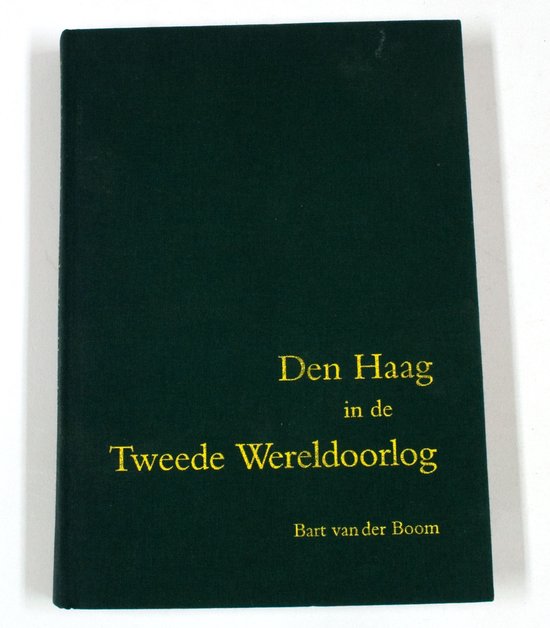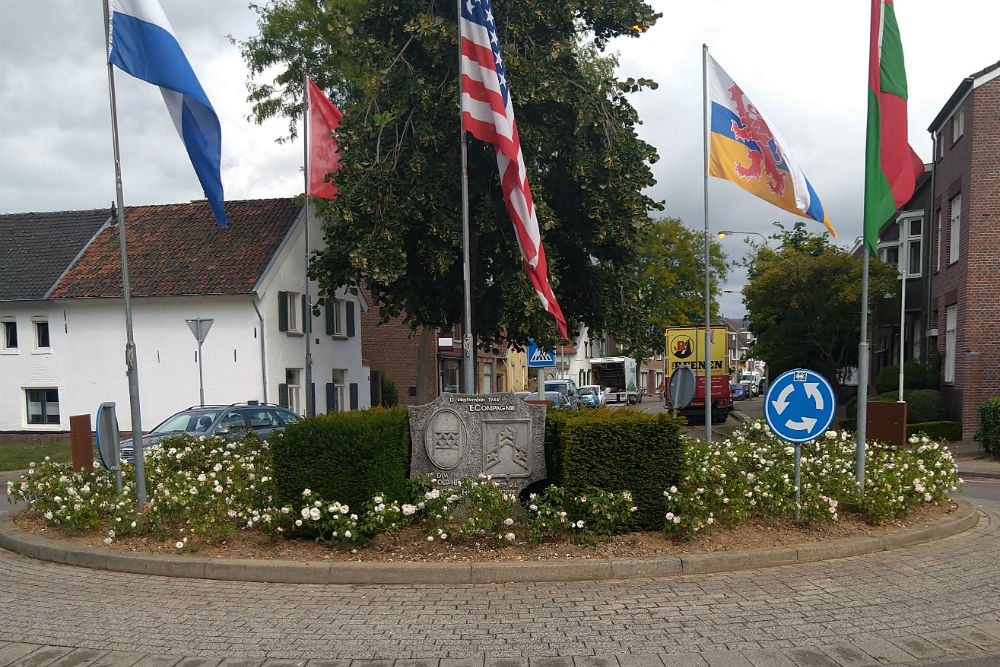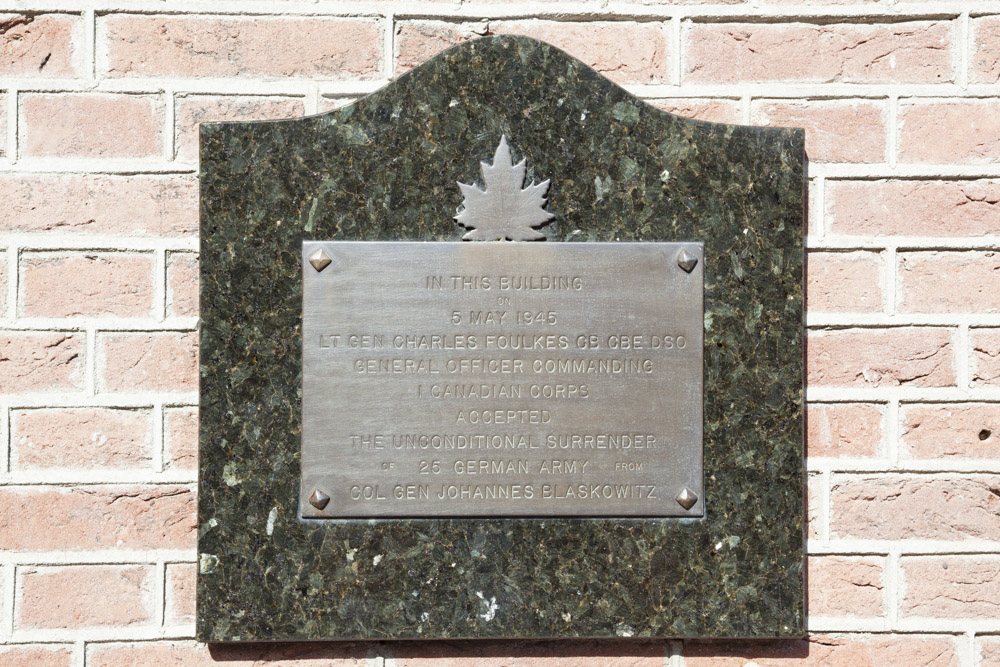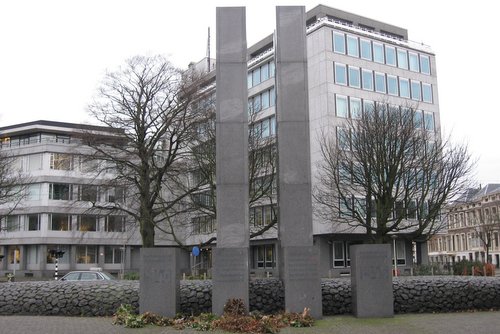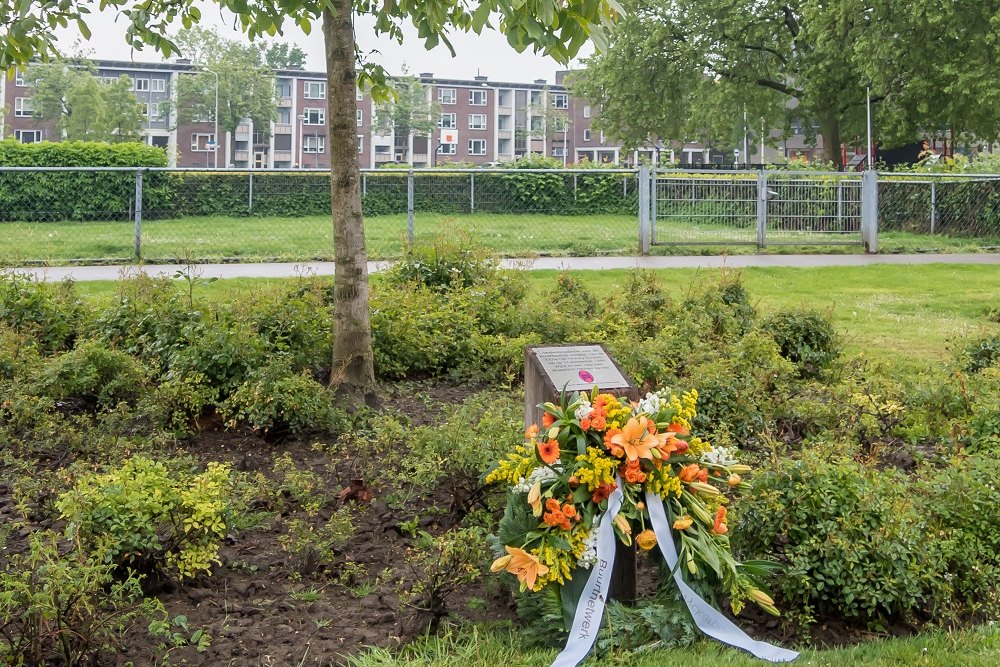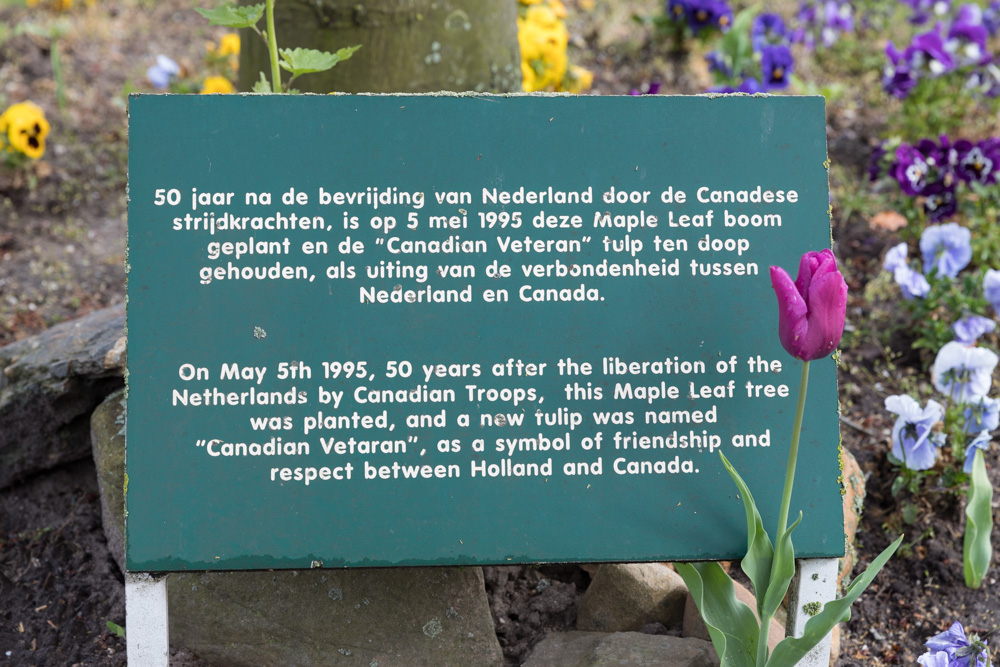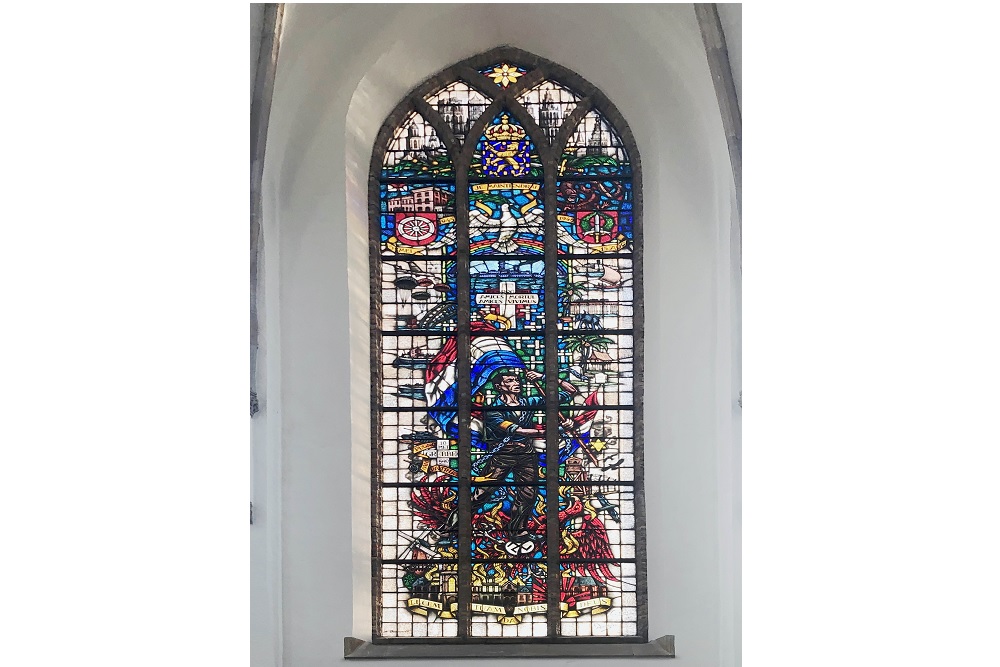Prologue
On September 4, 1944, Radio Oranje in London broadcasted a joyful message that after their speedy advance through France, the liberators would arrive in Breda. Prime Minister Pieter Gerbrandy made a mistake when reading from an intelligence report written by a British tank commander. He described a street called the Bredase baan and a pub called Café Breda which made Gerbrandy think British troops had crossed the Dutch border.[1] On Tuesday September 5, one day after this 'news' became known, the Dutch population got into a festive mood while the Germans and their followers fled in panic. The festivities were premature though. In reality, the Allies had halted before the Dutch border without any idea what the next step would be.
Liberation of the southern part
For the Allies, the liberation of the Netherlands was no priority because she shared a border with Germany. This caused the advance through Holland to proceed slowly with the liberation of the villages of Heesch and Noorbeek on September 12. Maastricht was occupied on September 14 after the German troops had fled the city the night before.[2]
Early September the question was raised in the Allied camp where to go next. Bernhard Montgomery, commander of the British 2nd Army, wanted to advance through the Netherlands, bypassing the Westwall and invading Germany from the west. In this way, the Allies could use the Dutch ports to deliver their supplies. On the other hand, Dwight Eisenhower, the Allied supreme commander wanted to create a broad front. The two agreed on a compromise: a broad front with Monty's units as the center of gravity.[3] This decision led to Operation Market Garden which was to be launched on September 17. The object of the operation was to have airborne troops capture the bridges near Son, Veghel, Grave, Nijmegen and Arnhem. At the same time, a British army corps (30 Corps) was to advance through the Netherlands in order to strike towards the IJsselmeer and trap the Germans in the western part of the country. In addition it was necessary to knock out the launching sites of the V-1s and V-2s, Hitler's vengeance weapons north of the large rivers which were to turn the tide of the war.
The advance through the south of the country grounded to a halt near Arnhem though. The Germans put up a fierce but unexpected resistance, a factor that wasn't reckoned with. On September 3, two battle-hardened German tank divisions had been ordered to relocate to Arnhem in order to be reinforced with veterans from the Eastern front. Moreover, in the vicinity of Arnhem there was a question of an exchange of equipment between two other German tank divisions causing much heavy equipment to be left behind. Because of the unexpected fierce resistance by veteran and well equipped units, the offensive had to halt near Nijmegen.[4]

Soldiers of the 101st Airborne consulting members of the Dutch resistance during Operation Market Garden. Source: Wikipedia/CIA
Definitielijst
- offensive
- Attack on a smaller or larger scale.
- resistance
- Resistance against the enemy. Often also with armed resources.
- Westwall
- Also known as Siegfried Line, the German defence line along the German-French border.
Famine in the northern part
Due to the failure of Market Garden, the northern part of the Netherlands entered a special period in its history, the Hongerwinter - the winter of famine. As the fighting in the south got under way, the government in London called for a railway strike. This was to obstruct the German transport of troops and equipment to the south but delivery of other products to the west also came to a halt. In the end, the railway strike had only minor influence on the movement of German troops as the German authorities had train drivers come to the Netherlands to take over the work from the Dutch railway company. In addition Seyss-Inquart, Reichskommissar für die besetzen Niederlände imposed an embargo on all transports of food and other products to the west as a penalty for the strike. This embargo was introduced in a period in which the supplies of the cities in the west should be replenished which resulted in a food intake of just 340 calories in February 1945.[5]
Hans Hirschfeld, Secretary-general of trade, commerce and shipping succeeded in stopping this embargo but it was too late. The shortages were too large. As a result of the severe frost and the shortage of fuel, vessels could no longer deliver food to the west causing a famine. As the southern part of the Netherlands had been liberated, delivery of coal from Limburg was impossible as well, resulting in a shortage of heat sources.[6] Research by historian G. Trienekens revealed a fourth reason for the suffering of the Dutch population during the Hongerwinter namely the political game between England, the Netherlands and Germany. It took to almost the last days of the war before the Allies started to support the Netherlands.[7] The situation was especially bad as from September, delivery of gas and electricity had been cut off. The Hague followed not much later on November 20 (gas) and October 30. Many households had to rely on the Tielman & Dros central kitchen on the Lange Gracht. Due to the growing crowds, 26 distribution points were active at the end of the war.[8]
Apart from the problems with shortages of food and heat sources, the west suffered from massive pillaging by the Germans. First of all, the ports of Rotterdam and Amsterdam were destroyed and all factories which had nothing to do with the production of food were robbed clean. Secondly, horses, cows, pigs and other cattle were systematically confiscated. In the spring, a special command arrived from Germany to confiscate horses; in the period between September and April to a total of 46,000 horses and 180,000 other cattle. Thirdly, stocks of textile were confiscated in the same way. Each household was compelled to submit textile to a maximum value of NLG 72.50.[9] Furthermore, The Hague suffered from an increasing number of bombardments because of the launching sites of the V1 and V2 located here. The Allies attempted to knock out these installation with a massive bombardment. The bombs missed their target however and landed in the Bezuidenhout, resulting in over 3,300 buildings destroyed or damaged, 520 persons losing their lives and 12,000 persons homeless.[10] Finally from November onwards, the number of razzias (round ups) increased to pick up all males between the ages of 17 and 40. These were put to work on the defensive lines on the IJssel or in German factories as they suffered from a shortage of personnel.
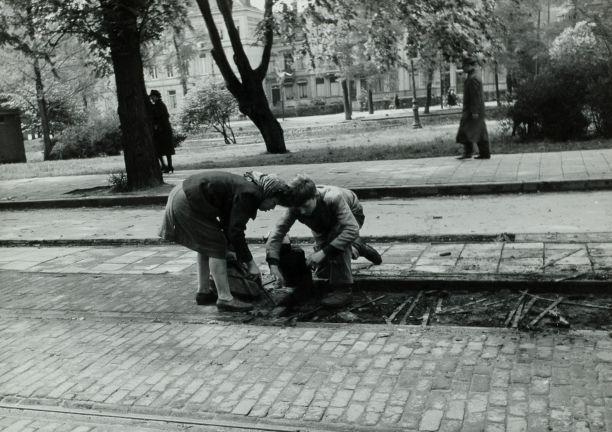
Children removing blocks of wood from the rails as a result of the fuel shortage of 1945. Source: Wikipedia/Nationaal Archief
Definitielijst
- heat
- High-explosive anti-tank warhead. Shaped charge projectile to punch through armour. Used in e.g. bazooka or in the Panzerfaust.
- railway strike
- This was announced on the radio and complied with by the Dutch railway staff on 17 September 1944. The railway strike was intended to support the allied plan Operation Market Garden. After the allied airborne landings had failed, Dutch railway staff remained on strike until the liberation.
- Reichskommissar
- Title of amongst others Arthur Seyss-Inquart, the highest representative of the German authority during the occupation of The Netherlands.
Liberation of the north and west
After the attack in the south had failed, the front in the Netherlands came to a halt. Fighting still continued in Zeeland, aimed at securing the mouth of the Scheldt so the port of Antwerp could be used. At the end of October, the German garrison in Middelburg surrendered and Zeeland was liberated.[11] After this no military actions took place on the Dutch front for a long time. This was first and foremost due to the focus of the Allies laying in the east near Germany with the main goal of invading Germany. In addition, there was great fear of heavy losses which would be suffered during an eventual capture of western Holland by inundation.[12] As late as March 30, Canadian units crossed the Dutch border in the Achterhoek which heralded the liberation of northern and eastern Holland. The aim was to cut off the troops in the Netherlands from Germany and establish a supply line between Arnhem and Zutphen. An attack on the western Netherlands by inundations and talks with Seyss-Inquart still didn't materialize.[13]
The Allies were justifiably worried. Festung Holland wouldn't surrender without a fight. In March 1945, Albert Speer, Minister of Armament and Seyss-Inquart discussed Hitler's order to apply the scorched-earth policy in the Netherlands. Both Speer and Seyss-Inquart rejected this order. On April 12, Seyss-Inquart quickly went to the Netherlands in order to start negotiations with the Allies. He permitted aid, provided they wouldn't advance beyond the Grebbe-linie This was one of his last attempts to show his good intentions in order to dodge possible prosecution for war crimes. Next day, he conducted talks with Hans Hirschfeld and Johannes Blaskowitz, commander of the German troops in Festung Holland. He explained to both what his plans for the Netherlands were and that he would ignore Hitler's orders. Initially, Blaskowitz feared military problems but in the end he agreed with the plans. He would continue to defend Festung Holland though.[14]
While the Canadians launched their attack near Arnhem, Seyss-Inquart and British representatives started negotiations about the termination of hostilities towards the western Netherlands. Seyss-Inquart was the first to request this on April 15. If the British would end hostilities, Germany would no longer carry out destructions and inundations. While famine continued in the west, the Allies halted their advance to the west before the Grebbe-linie. The advance north continued.[15] At the same time, deliveries to the cities of Rotterdam, The Hague, Leiden and Amsterdam were discussed. After four weeks of negotiations, it was decided to supply western Holland from the air.[16]
Next, negotiations were started between Canadian general Charles Foulkes, German general Blaskowitz and Prince Bernhard about surrendering Festung Holland. Meanwhile, Seyss-Inquart had fled the country by boat. The previously agreed armistice would be made into a general capitulation on May 5. This would be signed in Hotel De Wereld in Wageningen. In the end, signing took place a day later in the agricultural university in Wageningen. Blaskowitz couldn't meet all demands in time. For instance, he wanted to know for sure his troops wouldn't end up in Russian captivity. Despite the official capitulation being signed on May 6, the western Netherlands considered itself liberated on May 5 around 20:00. The 120,000 German military still present in the west were gradually disarmed.[17] On May 8, after an occupation that had lasted five years, Canadian troops entered The Hague, Leiden, Haarlem and Delft.
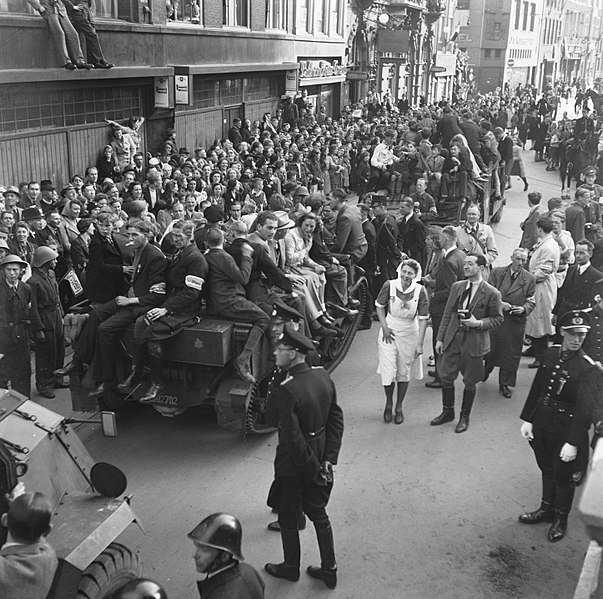
Celebration in The Hague with enthusiastic civilians around a Canadian Bren carrier. Source: Wikipedia/Nationaal Archief
Definitielijst
- capitulation
- Agreement between fighting parties concerning the surrender of a country or an army.
- inundation
- “Latin: No bottom”. The deliberate flooding of land with the aim of stopping or hindering the advance of the enemy into a certain area.
- war crimes
- Crimes committed in wartime. Often concerning crimes committed by soldiers against civilians.
Warfare in diaries
The meticulous following of the front and the hope for a speedy liberation was something that was recorded in diaries since the outbreak of the war. In 'We leven nog' De stemming in bezet Nederland, (We're still alive. The mood in occupied Holland) a book written by Bart van der Boom, the mood in the Netherlands during the years of war is described in a series of themes. One of these is the progress of the war. Van der Boom concludes that from the Dutch defeat in 1940 onwards, there was a mood of confidence among the diary writers. Each victory or defeat of the German Wehrmacht led to discussions. Many Dutch were confident of a speedy end of the occupation. German successes were swept under the rug or denied.[18]
In 1942 however, confidence shrank due to war-weariness, a cold winter, German victories in Africa and the Soviet Union and Japanese victories in Asia. People got the idea the war was going nowhere. Bartstra also noticed this change of mood. Only when the Wehrmacht was stopped at Stalingrad and El Alamein, joy among the Dutch rose once more. There was confidence in liberation again. According to the diary writers, waiting was the most important pastime while the news was being followed enthusiastically.[19] Yet, moments of insecurity remained:"Bij de bevolking in bezet gebied versterkten de berichten over het Ardennenoffensief de toch al bestaande gevoelens van teleurstelling." (Among the inhabitants of occupied territory, the news about the Ardennes offensive reinforces the existing mood of disappointment).[20] De Jong concludes that the last German counteroffensive caused insecurity among diary writers. In addition, despite the stocks of sufficient food in the first years of the war, even then people were afraid of malnutrition and one-sided food. People saw others getting skinnier but didn't go hungry themselves.[21]
Definitielijst
- Ardennes offensive
- Battle of the Bulge, “Von Rundstedt offensive“ or “die Wacht am Rhein“. Final large German offensive in the west from December 1944 through January 1945.
- El Alamein
- City in North Egypt. The Battle of El Alamein took place from October to November 1942 and was a turning point in the war. The German-Italian advance in North Africa was finally halted by the Allies.
- offensive
- Attack on a smaller or larger scale.
- Soviet Union
- Soviet Russia, alternative name for the USSR.
- Wehrmacht
- German armed military forces, divided in ground forces, air force and navy.
Conclusion
All told, it can be concluded that the liberation of the Netherlands didn't proceed without a hitch. The country has had to endure much before being freed from her German rulers. Why was Germany so determined to hold on to the Netherlands? The answer: strategic reasons for instance. First, the western provinces were used to bomb English cities with V-1s and V-2s after territory in France had been lost. Secondly, Amsterdam and Rotterdam possessed important ports the Allies could use in their advance on Berlin. Finally, the Netherlands were a 'fertile' country from which much food, clothing and many men, animals, machines etc. were stolen during the war to the advantage of the war industry. For that reason, Arnhem had been fiercely defended and it had taken very long before the mouth of the Wester Scheldt could be reopened. The north of the country was invaded as late as April 1945 and was entirely liberated in four weeks. The west remained occupied until May 6. The festivities here could only begin after the official capitulation of the German troops on May 6.
See also:
Celebrations in The Netherlands
Last month of the war in the Neherlands
Notes
- Ad van Liempt, Na de bevrijding - De loodzware jaren 1945-1950 (Steenwijk 2014) 7.
- Ad van Liempt, Na de bevrijding - De loodzware jaren 1945-1950 (Steenwijk 2014) 10/11.
- Christ Klep en Ben Schoenmaker, De bevrijding van Nederland 1944-1945: Oorlog op de flank ('s-Gravenhage 1995) 52.
- L. de Jong, Het Koninkrijk der Nederlanden in de Tweede Wereldoorlog deel Xa ('s-Gravenhage 1981) 334-335.
- Bart van der Boom, Den Haag en de Tweede Wereldoorlog ('s-Gravenhage 1995) 240.
- L. de Jong, Het Koninkrijk der Nederlanden in de Tweede Wereldoorlogdeel Xb ('s-Gravenhage 1981) 160.
- G. Trienekens, Voedsel en honger in oorlogstijd 1940-1945. Misleiding, mythe en werkelijkheid (Utrecht 1995) 78.
- Alphons Siebelt, Gids voor Leiden in de Tweede Wereldoorlog beschreven in 650 adressen (Leiden 2011) 45.
- L. de Jong, Het Koninkrijk der Nederlanden in de Tweede Wereldoorlogdeel Xb ('s-Gravenhage 1981) 73.
- Bart van der Boom, Den Haag en de Tweede Wereldoorlog ('s-Gravenhage 1995) 235.
- Christ Klep en Ben Schoenmaker, De bevrijding van Nederland 1944-1945: Oorlog op de flank ('s-Gravenhage 1995) 202.
- J. Dankers en J. Verheul, Bezet Gebied Dag In Dag Uit - Nederland en Nederlands-Indië in de Tweede Wereldoorlog Een chronologisch overzicht (Haarlem 1985) 145.
- J. Dankers en J. Verheul, Bezet Gebied Dag In Dag Uit - Nederland en Nederlands-Indië in de Tweede Wereldoorlog Een chronologisch overzicht (Haarlem 1985) 146.
- Hendrik van der Zee, De Hongerwinter - Van Dolle Dinsdag tot Bevrijding (Amsterdam 1979), 200-201.
- Christ Klep en Ben Schoenmaker, De bevrijding van Nederland 1944-1945: Oorlog op de flank ('s-Gravenhage 1995) 310.
- Hendrik van der Zee, De Hongerwinter - Van Dolle Dinsdag tot Bevrijding (Amsterdam 1979), 208
- Paul Arnoldussen en Albert de Lange, Finale mei: het einde van de oorlog in Nederland (Amsterdam 1995) 13.
- Bart van der Boom, 'We leven nog' De stemming in bezet Nederland (Amsterdam 2003) 100-104.
- Bart van der Boom, 'We leven nog' De stemming in bezet Nederland (Amsterdam 2003) 108-111.
- L. de Jong, Het Koninkrijk der Nederlanden in de Tweede Wereldoorlog Xb ('s-Gravenhage 1981) 791.
- Bart van der Boom, 'We leven nog' De stemming in bezet Nederland (Amsterdam 2003) 70-73
Definitielijst
- capitulation
- Agreement between fighting parties concerning the surrender of a country or an army.
Information
- Article by:
- Joshua Rijsdam
- Translated by:
- Arnold Palthe
- Published on:
- 28-01-2023
- Last edit on:
- 05-02-2023
- Feedback?
- Send it!
Related sights
Related books
Sources
- BOOM, B. VAN DER, 'We leven nog', Boom uitgevers Amsterdam, Amsterdam, 2003.
- BOOM, B. VAN DER, Den Haag in de Tweede Wereldoorlog, Uitgeverij Lakerveld B.V., Den Haag, 2004.
- JONG, L. DE, Het Koninkrijk der Nederlanden in de Tweede Wereldoorlog 10, Staatsuitgeverij, Den Haag, 1969.
- KLEP, C. & SCHOENMAKER, B., de bevrijding van nederland 1944-1945, Sdu Uitgevers.
- LIAGRE BOHL, De bevrijding van Amsterdam, WBOOKS, Amsterdam, 1989.
- LIEMPT, A. VAN, Na de bevrijding, Uitgeverij Balans, 2014.
